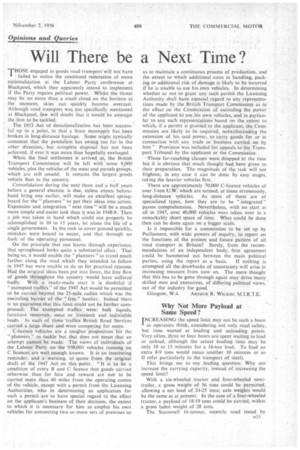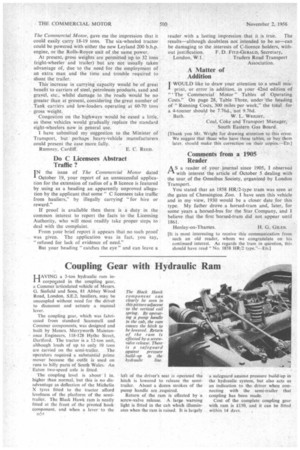Opinions and Queries
Page 63

Page 64

If you've noticed an error in this article please click here to report it so we can fix it.
Will There be a Next Time?
THOSE engaged in goods road transport will not have
failed to notice the continued reiteration of more nationalization at the Labour Party conference at Blackpool, which they apparently intend to implement if the Party regains political power. Whilst the threat may be no more than a small cloud on the horizon at the moment, skies can quickly become overcast. Although road transport was not specifically mentioned at Blackpool, few will doubt that it would be amongst the first to be tackled.
The 1953 Act of denationalization has been successful up to a point, in that a State monopoly has been broken in long-distance haulage. Some might cynically comment that the pendulum has swung too far in the other direction, but complete disposal has not been achieved, if ever it was more than hopefully envisaged.
When the final settlement is arrived at, the British Transport Commission will be left with some 9,000 vehicles, plus the vehicles of the meat and parcels groups, which are still unsold. It remains the largest goods vehicle fleet in the country. _ .
Consolidation during the next three and a half years before a general election is due, unless events beforehand bring one earlier, will make an excellent springboard for the "planners" to put their ideas into action. Expansion and integration " next time" will be a much more simple and easier task than it was in 1948-9. Then a job was taken in hand which could not properly be accomplished in 10 to 15 years, let alone the life of a single government. In the rush to cover ground quickly, mistakes were bound to occur, and that through no fault of the operating personnel.
On the principle that one learns through experience, that springboard looks quite a substantial affair. That being so, it would enable the "planners "to travel much farther along the road which they intended to follow in 1947 but were unable to do so for practical reasons. Had the original ideas been put into force, the free flow of goods throughout the country would have suffered badly. With a ready-made start it is doubtful • if " exempted traffics," of the 1947 Act would be permitted to be carried beyond the 25-mile radius which was the encircling barrier of the " free " haulier. Indeed there is no guarantee that this limit could not be further compressed. The exempted traffics were: bulk liquids, furniture removals, meat or livestock and indivisible loads. In each of those traffics British Road Services carried a large share and were competing for more.
C-licence vehicles are a tougher proposition for the "planners " to tackle• but that does not mean that an attempt cannot be made. The views of individuals of the Labour Party on the 950,000 vehicles running on C licences are well enough known. It is an interesting reminder, and a warning, to quote from the original draft of the 1947 Act on this point. "It is to be a condition of every B and C licence that goods carried otherwise than for hire and reward are not to be carried more than 40 miles from the operating centre of the vehicle, except with a permit from the Licensing Authorities, who in determining an application for such a permit are to have special regard to the effect on the applicant's business of their decision, the extent to which it is necessary for him to employ his own vehicles for connecting two or more sets of premises so
as to maintain a continuous process of production, and the extent to which additional costs in handling, packing or additional risk of damage is likely to be incurred if he is unable to use his own vehicles. In determining whether or not to grant any such permit the Licensing Authority shall have especial regard to any representations made by the British Transport Commission as to the effect on the Commission of extending the power of the applicant to use his own vehicles, and in particular to any such representations based on the extent to which, if a permit is granted to the applicant, the Commission are likely to be required, notwithstanding the extension of his said power, to carry goods for or in connection with any trade or business carried on by him" Provision was included for appeals to the Transport Tribunal by the applicant or the Commission.
-Those far-reaching clauses were dropped -ht the time but it is obvious that much thought had been given to their preparation. The magnitude of the task will not frighten; in any case it can be done by easy stages, taking the heavier vehicles first.
. There are approximately 70,000 C-licence vehicles of over 3-ton U.W.'which arc termed, at times erroneously, long-distance vhicles. As most of them are of specialized types, how they are to be "integrated " passes comprehension. Nevetatheless, with no start at all in 1947, over 40,000 vehicles were taken over in a remarkably short space of time. What could be done then can be done again on a bigger scale.
Is it impossible for a commission to be setup by Parliament, with wide powers of inquiry, to report on the functions of the present and future pattern of all road transport in Britain? Surely, from the recommendations of an independent body, firm agreement could be hammered out between the main political parties, using the report as a basis. If nothing is attempted all the drawbacks of uncertainty will arise in increasing measure from now on. The mere thought that this has to be gone through again may drive many skilled men and executives, of differing political views, out of the industry for good.
Glasgow, W.4. ARTHUR R. WILSON; M.I.R.T.E.
Why Not More Payload at Same Speed?
iNCREASING the speed limit may not be such a boon A as operators think, considering not only road safety, but time wasted at loading and unloading points. Very often, three or four hours are spent waiting to load or unload, although the actual loading time may be only 10 to 15 minutes for a 16-ton load. To load an extra 8-9 tons would mean another 10 minutes or so (I refer particularly to the transport of steel).
This brings me to .my leading question: Why not increase the carrying capacity, instead of increasing the speed limit?
With a six-wheeled tractor and four-wheeled semitrailer, a gross weight of 36 tons could be permitted, allowing a net load of 24-25 tons; axle weights would be the same as at present. In the case of a four-wheeled tractor, a payload of 18-19 tons could be carried, within a gross laden weight of 28 tons.
The Scammell 16-tonner, recently road tested by
The Commercial Motor, gave me the impression that it could easily carry 18-19 tons. The six-wheeled tractor could be powered with either the new Leyland 200 b.h.p. engine, or the Rolls-Royce unit of the same power.
• At present,•gross weights are permitted up to 32 tons (eight-wheeler and trailer) but are not usually taken advantage of, due to the need for the employment of an extra man and the time and trouble required to shunt the trailer.
This increase in carrying capacity would be of great benefit to carriers of steel, petroleum products, sand and gravel, etc., whilst damage to the roads would be no greater than at present, considering the great number of Tank carriers and low-loaders operating at 60-70 tons gross weight.
.Congestion on the highways • would be eased a little, as these vehicles would gradually replace the standard eight-wheelers now in general use.
I have submitted my suggestion to the Minister of Transport, but perhaps heavy-vehicle manufacturers could present the case more fully.
Rumn ey, Cardiff. E. C. REED.
Do C Licensees Abstract Traffic ?
IN the issue of The Commercial Motor dated I October 19, your report of an unsuccessful application for the extension of radius of a B licence is featured by using as a heading an apparently unproved allegation by the applicant that some" C licensees take traffic from hauliers," by illegally carrying "for hire or reward."
If proof is available then there is a duty in the common interest to report the facts to the Licensing Authority, who will most readily take proper steps to deal with the complaint.
From your brief report it appears that no such proof was given. The application was in fact, you say, "refused for lack of evidence of need."
But your heading "catches the eye" and can leave a reader with a lasting impression that it is true. The results—although doubtless not intended to be so—can be damaging to the interests of C-licence holders, with
out justification. F. D. FITZ-GERALD, Secretary,
London, W.1, Traders Road Transport Association.
A Matter of Addition
WOULD like to draw your attention to a small misprint, or error in addition, in your 42nd edition of "'The Commercial Motor" Tables of Operating Costs."' On page 28, Table Three, under the heading of " Running Costs, 300 miles per week," the total for a 4-tonner should be 7.76d, not 9.76d.
Bath. W. L. WRICHT,
Coal, Coke and Transport Manager; South Eastern Gas Board.
(Thank you Mr. Wright for drawing attention to this error. Wesuggest that those who have these tables, or buy them
• later, should make this correction on their copies.—ED1
Comments from a 1905 Reader
A5 a reader of your journal since 1905, I observed with interest the article of October 5 dealing with the tour. of the Omnibus Society, organized by London Transport.
You stated that an 1858 HR/2-type tram was seen at the gates of Chessington Zoo. I have seen this vehicle and in my view, 1930 would be a closer date for this type. My father drove a horsed-tram and, later, for some years a horsed-bus for the Star Company, and I believe that the first "horsed-tram did not appear until 1861.
Henley-on-Thames. H. G. GILES.
[It is most interesting to receive this communication from such an old reader, whom we congratulate on his continued interest. As regards the tram in question, this should have read "No. 1858 F11212 type."—ED.1
















































































































